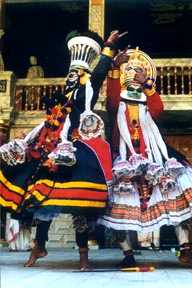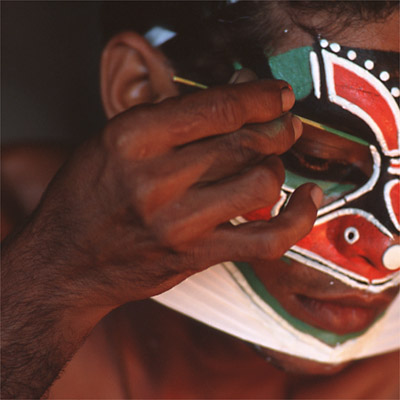|
Kathakali is one of the oldest theatre forms in the world. It originated in the area of southwestern India now known as the state of Kerala. Kathakali is a group presentation, in which dancers take various roles in performances traditionally based on themes from Hindu mythology, especially the two epics, the Ramayana and the Mahabharata and from the Puranas (ancient scriptures).
 The dancers adorn themselves in huge skirts and head-dress, wearing a most intricate style of make-up. The dancers adorn themselves in huge skirts and head-dress, wearing a most intricate style of make-up.
Kathakali draws heavily from drama and is danced with elaborate masks and costumes.
Kathakali recitals are generally long and while other dance forms are more emotive than narrative, Kathakali is both. It combines dance with dialogue to bring myth and legend to life in the temple courtyards of Kerala. The dancers use their stunning costumes and make-up, with the accompaniment of drums and vocalists, to create various moods and emotions.
The technique of Kathakali includes a highly developed language of gesture, through which the artist can convey whole sentences and stories. The body movements and footwork are very rigourous. To attain the high degree of flexibility and muscle control required for this art, a Kathakali dancer undergoes a strenuous course of training, and special periods of body massage.
One of the most interesting aspects of Kathakali is its elaborate make-up code. Characters are categorized according to their nature. This determines the colours used in the make-up. The faces of noble male characters, such as virtuous kings, the divine hero Rama, etc., are predominantly green. Characters of high birth who have an evil streak, such as the demon king Ravana, are allotted a similar green make-up, slashed with red marks on the cheeks. Extremely angry or excessively evil characters wear predominantly red make-up and a flowing red beard. Forest dwellers such as hunters are represented with a predominantly black make-up base. Women and ascetics have lustrous, yellowish faces. Characters are categorized according to their nature. This determines the colours used in the make-up. The faces of noble male characters, such as virtuous kings, the divine hero Rama, etc., are predominantly green. Characters of high birth who have an evil streak, such as the demon king Ravana, are allotted a similar green make-up, slashed with red marks on the cheeks. Extremely angry or excessively evil characters wear predominantly red make-up and a flowing red beard. Forest dwellers such as hunters are represented with a predominantly black make-up base. Women and ascetics have lustrous, yellowish faces.
|